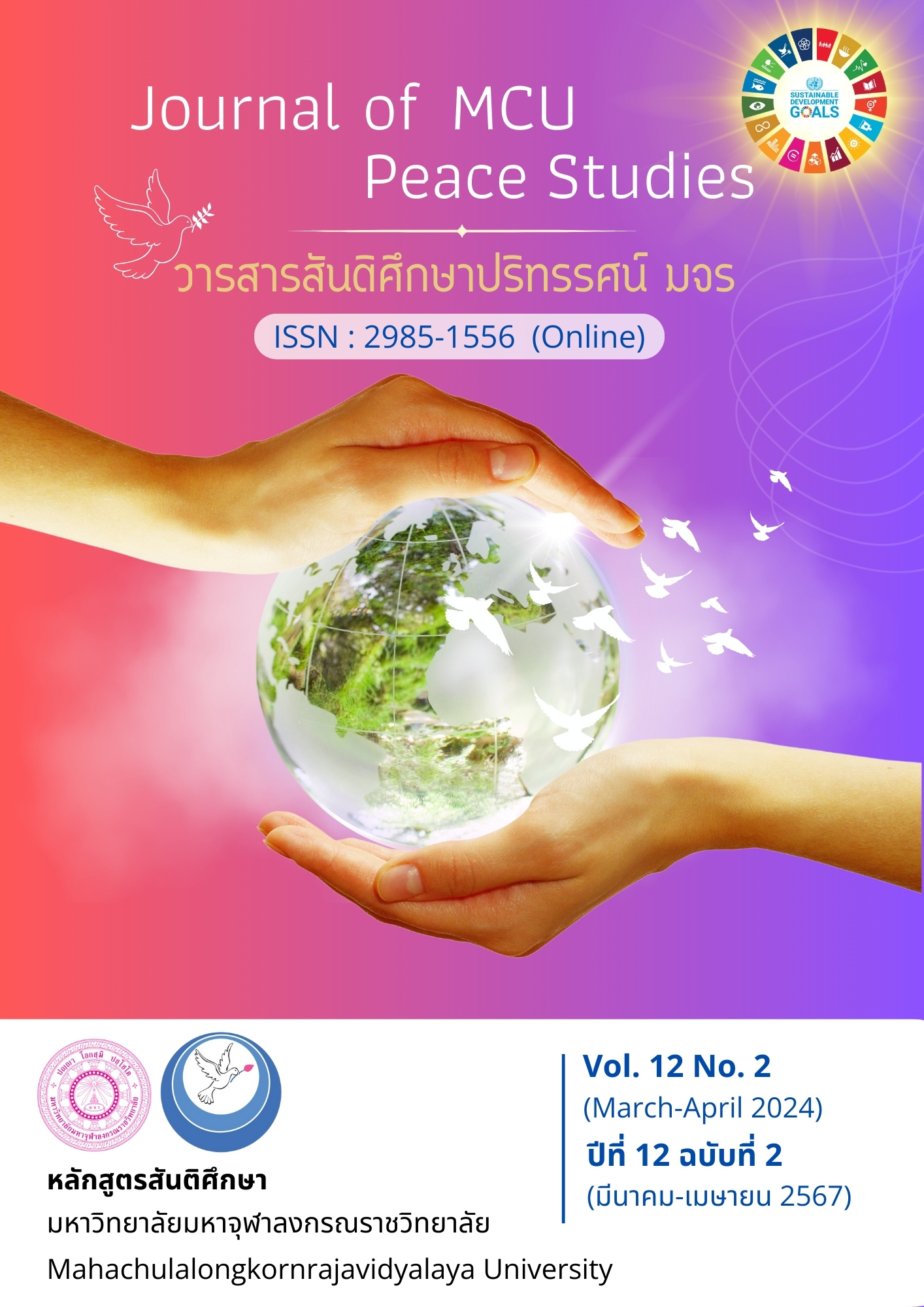A Process for Developing Volunteer Mediators to Manage Family Conflict in Wat Mai (Yai Paen) Community by Buddhist Peaceful Means
Main Article Content
Abstract
The research article consisted of the following objectives: 1) to investigate context, problems, and needs of a process for developing volunteer mediators to manage family conflict in Wat Mai (Yai Paen) community; 2) to analyze the Buddhist peaceful means favorable to a process for developing volunteer mediators to manage family conflict in Wat Mai (Yai Paen) community; and 3) to present a process for developing volunteer mediators to manage family conflict in Wat Mai (Yai Paen) community by Buddhist peaceful means. The study was based on Ariyasacca (the Four Noble Truths) model in accordance with participatory action research under the 9-step research framework. Groups of qualitative and quantitative data providers include: monks, teachers, community leaders, and volunteers total of 15 people, Wat Mai (Yai Paen) community by interviewing, training, mediation practice and evaluation. Analyze data, present descriptive and statistics.
From the study, the following results are found: 1) Wat Mai (Yai Paen) has a few connections between families, communities, temples, and government sectors. The community is unable to rely on itself and requires support from outside organizations as well as government sectors. 2) The Buddhadhamma conducive to a process for developing volunteer mediators to manage family conflict are (1) Tisikkhā (the threefold training); (2) Brahmavihāra (the four sublime states of mind); and (3) Saṅgahavatthu (the four bases of social solidarity). 3) A process for developing volunteer mediators to manage family conflict in Wat Mai (Yai Paen) community by Buddhist peaceful means is required by families in the community. Volunteer mediators should be equipped with knowledge, traits, and skills in managing family conflicts, including Tisikkhā, Brahmavihāra, and Saṅgahavatthu. The study has resulted in a mediation process called ‘Mediation Model,’ consisting of the following nine steps: (1) Mindfulness; (2) Emotional management; (3) Deep listening; (4) Issue analysis; (5) Attitude equation; (6) Trust; (7) Interest; (8) Options; and (9) New future and relationship. The posttest results after the training course are higher than the pretest, with a statistical significance level of 0.05.
Article Details

This work is licensed under a Creative Commons Attribution-NonCommercial-NoDerivatives 4.0 International License.
Views and opinions expressed in the articles published by The Journal of MCU Peace Studies, are of responsibility by such authors but not the editors and do not necessarily reflect those of the editors.
References
Bernard, M. (2010). Dynamic in Conflict Resolution [Medical Doctor]. (Tanteerawong, Translator). Bangkok: Kobfai.
Buranasingh, T., Phramaha Hansa Dhammahaso, & Phra Pramote Vadakovido. (2020). A Judicial Public Mediation Model for People by Buddhist Peaceful Means: Case Study of Sawai Sub-District, Prang Ku District, Sri Sa Ket Province, (Doctoral Dissertation). Mahachulalongkornrajavidyalaya University. Ayutthaya.
Chotisakulrat, P., Maneekaw, N. (2016). Peace Building Communication: Turning Conflict into Creative Power. Nakhon Pathom: Human Rights and Peace Studies Institute, Mahidol University.
Department of Rights and Freedoms Protection. (2022). Strategy for 20 Years (2017-2036) Dispute Mediation Act 2019. Retrieved January 10, 2022, from http//www.rlpd.go.th
Fisher, R., Ury, W., & Patton, B. (1991). Getting to Yes: Negotiating Agreement without Giving in. 2nd ed., Massachusetts, USA: Houghton Mifflin Harcourt.
Hellriegel, D., & Slocum, J. W. (2002). Management: A Competency-based Approach. Ohio: Cincinnati.
Kanchanakamol, U. (2008). Community Development Based on Community Assets and Aesthetic Questions. Bangkok: King Prajadhipok's Institute.
Lappitakmongkol, P. et al. (2019). A Development of Mediator Characteristics at Samutprakarn Provincial Court by Buddhist Peaceful Means. Journal of MCU Peace Studies, 7(5), 1283-1295.
Mahachulalongkornrajavidyalaya University. (1996). Thai Tripitakas. Bangkok: MCU Press.
Moore, Ch. W. (1947). Summary of the Mediation Process: Practical Strategies for Resolving Conflict. (4th ed.). San Francisco: Jossey-Bass Publishers.
NESDC (Office of the National Economic and Social Development Council). (2018). Document Summarizing the Master Plan under the National Strategy (2018-2037) No. 22: Law and Justice Process (pp. 134). Retrieved June 22, 2023, from https://www.bic.moe.go.th/images/stories/pdf/National_Strategy_Summary.pdf
Phra Anurak Anurakkhito (Ratthatham). (2023). A Model Youth Leaders Through Moral Training by Buddhist Peaceful Means in Nakhon Si Thammarat Province. Journal of MCU Peace Studies, 11(2), 667-680.
Phramaha Hansa Dhammahaso (Nitibunyakorn). (2004). Water War of the Mae Ta Chang Basin, Chiang Mai: Concept and Tools for Conflict Management in Buddhist Perspective. (Doctoral Dissertation). Mahachulalongkornrajavidyalaya University. Ayutthaya.
Phramaha Hansa Dhammahaso (Nitibunyakorn). (2023). Buddhist Peaceful Means: Integration of Principles and Tools for Conflict Management. Bangkok: Prayoorasanthai Printing.
Pratheuangrattana, C. (2022). Mediation by Mediator; The Path to Managing Conflict by Creating Mutual Understanding Office of Peace and Good Governance. Bangkok: Office of Peace and Good Governance, King Prajadhipok's Institute.
Sa-nguanchom, P., & Phra Pramote Vadakovido. (2022). A Model of Development of Prototype Facilitative Leaders for Peace by Buddhist Peaceful Means. Journal of MCU Peace Studies, 10(7), 133-143.
Taba, H. (1962). Curriculum Development: Theory and Practice. New York: Harcourt Brace & World.
Thabvongse, C. (2019). Handbook of Negotiator. Bangkok: Sangchan Printing.
Tyler, R. W. (1949). Basic Principle of Curriculum Instruction. Chicago: The University of Chicago Press.
UNESCO. (2022). Peace, Justice and Strong Institutions: Promote Peaceful and Inclusive Societies for Sustainable Development, Provide Access to Justice for All and Build Effective, Accountable and Inclusive Institutions at All Levels. Retrieved January 10, 2023, from https://www.globalgoals.org/goals/16-peace-justice-and-strong-institutions/
Wattanasub, W. (2012). Conflict: Principles and Resolution Tools. (4th ed.). Khonkan: Kangnana Wittaya Press.

